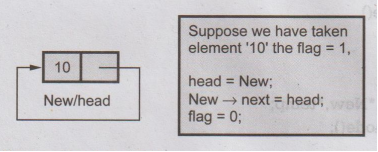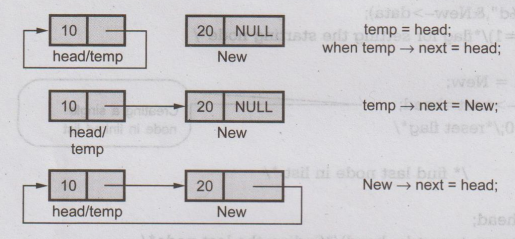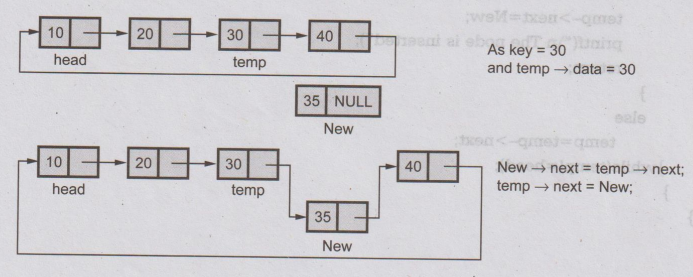C Programming and Data Structures: Unit III: a. Linear Data Structures - List
Circular Linked List
Definition, Operation, Structure, Example C programs, Advantages, Applications
• Definition: The Circular Linked List (CLL) is similar to singly linked list except that the last node's next pointer points to first node.
Circular
Linked List
AU: Dec.-18, Marks 6
• Definition: The Circular Linked List
(CLL) is similar to singly linked list except that the last node's next pointer
points to first node.
•
The circular linked list is as shown below -

•
Various operations that can be performed on circular linked list are,
1.
Creation of circular linked list.2. Insertion of a node in circular linked
list.
3.
Deletion of any node from linked list. 4. Display of circular linked list.
We
will see each operation along with some example.
1. Creation of circular linked list
struct
node *Create()
{
char
ans;
int
flag=1;
struct
node *head,*New,*temp;
struct
node *get_node();
clrscr();
do
{
New
= get_node();
printf("\n\n\n\tEnter
The Element\n");
scanf("%d",
&New->data);
if(flag==1)/*flag
for setting the starting node*/
{
head
= New;
New->next=head;
Creating a single node in linked list
flag=0;/*reset
flag*/
}
Else
/* find last node in list */
{
temp-head;
while
(temp->next!= head)/*finding the last node */
temp-temp->next;
/*temp is a last node */
temp->next=New;/*
attaching the node*/
New->next-head;
/*each time making the list circular*/
}
printf("\n
Do you want to enter more nodes?");
ans=getch();
}
while(ans =='y' || ans == 'Y');
return
head;
}
/*
function used while allocating memory for a node*/
struct
node *get_node()
{
struct
node *New;
New
(node *) malloc(sizeof(struct node));
New->next
= NULL;
return(New);/*created
node is returned to calling function*/
}
Initially
we will allocate memory for New node
using a function get_node(). There
is one variable flag whose purpose
is to check whether first node is created or not. That means flag is 1 (set)
then first node is not created. Therefore after creation of first node we have
to reset the flag (making flag = 0).
Initially,

Here
variable head indicates starting
node.
Now
as flag = 0, we can further create the nodes and attach them as follows.
When
we have taken element '20'

If
we want to insert 30 then

If
we want to insert 40 then

Thus
we can create a circular linked list by inserting one no one more element 50.
It is as shown :

2. Display of circular linked list
void
Display(struct node *head)
{
struct
node *temp;
temp
= head;
if(temp
== NULL)
printf("\n
Sorry,The List Is Empty\n");
else
{
do
{
printf("%d\t",temp->data);
temp
= temp->next;
}
while(temp != head);, The next node of last node is head node
}
getch();
}
3. Insertion of circular linked
list
While
inserting a node in the linked list, there are 3 cases -
a)
Inserting a node as a head node
b)
Inserting a node as a last node
c)
Inserting a node at intermediate position
The
functions for these cases is as given below -
struct
node *insert_head(struct node *head)
{
struct
node *get_node();
struct
node *New,*temp;
New=get_node();
printf("\n
Enter The element which you want to insert ");
scanf("%d",&New->data);
if(head
== NULL)
head=New;
else
{
temp=head;
while(temp->next!=head)
temp=temp->next;
temp->next=New;
New->next
= head;
head=New;
printf("\n
The node is inserted!");
}
return
head;
}
/*Insertion
of node at last position*/
void
insert_last(struct node *head)
{
struct
node *New,*temp;
New=get_node();
printf("\n
Enter The element which you want to insert ");
scanf("%d",
&New->data);
if(head
== NULL)
head=
New;
else
{
temp=head;
while(temp->next!=head)
temp=temp->next;
temp->next=New;
New->next
= head;
printf("\n
The node is inserted!");
}
}
void
insert_after(struct node *head)
{
int
key;
struct
node *New,*temp;
New=
get_node();
printf("\n
Enter The element which you want to insert ");
scanf("%d",
&New->data);
if(head
== NULL)
{
head=New;
}
else
{
printf("\n
Enter The element after which you want to insert the node ");
scanf("%d",
&key);
temp=head;
do
{
if(temp->data==key)
{
New->next-temp->next;
temp->next=New;
printf("\n
The node is inserted"); D-ED-ED-ED
return;
}
else
temp-temp->next;
}while(templ=head);
}
}
Suppose linked list is already created as

If
we want to insert a New node as a last node consider a linked list

If
we want to insert an element 35 after node 30 then,

4. Deletion of any node
struct
node *Delete(struct node *head)
{
int
key;
struct
node *temp, *temp1;
printf("\n
Enter the element which is to be deleted");
scanf("%d",
&key);
temp=head;
if(temp->data==key)/*If
header node is to be deleted*/inil s botes svari sw seqque
{
temp1=temp->next;
If a single node is present in the list and we want to delete it
if(temp1==temp)
{
temp=NULL;
head=temp;
printf("\n
The node is deleted");
}
else
{
while(temp->next!=head)
temp-temp->next;/*searching
for the last node*/
temp->next=temp1;
head=temp1;/*new
head*/
printf("\n
The node is deleted");
}
}
else
{
while(temp->next!=head)
/* if intermediate node is to be deleted*/
{
if((temp->next)->data==key)
The previous node of the node to be deleted is searched. temp1 is the node to
be deleted
{
temp1=temp->next;
temp->next-temp1->next;
temp1->next=NULL;
free(temp1);
printf("\n
The node is deleted");
}
else
temp-temp->next;
}
}
return
head;
}
Suppose
we have created a linked list as,

If
we want to delete temp → data i.e. node 10 then,

If
we want to delete an intermediate node from a linked list which is given below

The
linked list can be -
5. Searching a node from circular
linked list
struct
node *Search(node *head,int num)
{
struct
node *temp;
temp=head;
while(temp->next!=head)
{
if(temp->data
== num)
return
temp; /*if node is found*/
else
temp=temp
-> next
}
return
NULL;
}
while
searching a node from circular linked list we go on comparing the data field of
each node starting from the head
node. If the node containing desired data is found we return the address of
that node to calling function.
Ex.
3.8.1: Implementation of circular linked list
/*********************************************************
Program
To Perform The Various Operations On The Circular Linked List
*************************************************************/
#include<stdio.h>
#include<stdlib.h>
#include<conio.h>
struct
node
{
int
data;
struct
node *next;
};
void
main()
{
char
ch;
int
num,choice;
struct
node *head, *New,*temp;
struct
node *Create(void);
void
Display(struct node *);
struct
node *Insert(node *);
struct
node *Delete(struct node *);
struct
node *Search(struct node *,int);
head=NULL;
do
{
clrscr();
printf("\n
Program For Circular Linked List\n");
printf("
1.Insertion of any node\n\n");
printf("
2. Display of Circular List\n\n");
printf("
3. Insertion of a node in Circular List\n\n");
printf("
4. Deletion of any node \n\n");
printf("
5. Searching a Particular Element in The List\n\n");
printf("
6.Exit");
printf("\n
Enter Your Choice"); sino
scanf("%d",
&choice);
switch(choice)
{
case
1 :head=Create();
break;
case
2 :Display(head);
break
case
3:head=Insert(head);
break;
case
4:head=Delete (head);
break;
case
5:printf("\n Enter The Element Which Is To Be Searched");
scanf("%d",
&num);
temp
Search(head,num);
if(temp!=
NULL)
printf("\n
The node is present");
else
printf("\n
The node is not present");
break;
case
6:exit(0);
}
printf("\nDo
you want to go to Main Menu?\n");
ch=getch();
}
while(ch== 'y' || ch == 'Y');
}
struct
node *Create()
{
char
ans;
int
flag=1;
struct
node *head, *New, *temp;
struct
node *get_node();
clrscr();
do
{
New
= get_node();
printf("\n\n\n\tEnter
The Element\n");
scanf("%d",&New->data);
if(flag==1)
/*flag for setting the starting node*/
{
head
=New;
New->next
= head; /*the circular list of a single node*/
flag=0;/*reset
flag*/
}
else
/* find last node in list */
{
temp=head;
while
(temp->next!= head)/*finding the last node*/)
temp=temp->next;
/*temp is a last node*/
temp->next=New;
New->next-head;
/*each time making the list circular*/
}
printf("\n
Do you want to enter more nodes?");
ans=getch();
}while(ans=='y'
|| ans == 'Y');
return
head;
}
struct
node *get_node()
{
struct
node *New;
New
(node *) malloc(sizeof(struct node));
New->next
= NULL;
return(New);/*created
node is returned to calling function*/
}
void
Display(struct node *head)
{
struct
node *temp;
temp
= head;
if(temp
==NULL)
printf("\n
Sorry,The List Is Empty\n");
else
{
do
{
printf("%d\t",temp->data);
boa pitiate ori prie rol ge*\_(==gs)
temp
= temp->next;
}
while(temp != head);/*Circular linked list*/
}
getch();
}
struct
node *Insert(node *head)
{
int
choice;
struct
node *insert_head(node *);
void
insert_after(struct node *);
void
insert_last(struct node *);
printf("\n
1. Insert a node as a head node");
printf("\n
2. Insert a node as a last node");
printf("\n
3. Insert a node at intermediate position in the linked list");
printf("\n
Enter your choice for insertion of node");
scanf("%d",
&choice);
switch(choice)
{
case
1: head=insert_head(head);
break;
case
2: insert_last(head);
break;
case
3: insert_after(head);
break;
}
return
head;
}
struct
node *insert_head(struct node *head)
{
struct
node *get_node();
struct
node *New,*temp;
New=get_node();
printf("\n
Enter The element which you want to insert ");
scanf("%d",
&New->data);
if(head=
NULL)
head=New;
else
{
temp=head;
while(temp->next!=head)
temp=temp->next;
temp->next=New;
New->next-head;
head=New;
printf("\n
The node is inserted!");
}
return
head; }
/*Insertion
of node at last position*/
void insert_last(struct node *head)
{
struct
node *New,*temp;
New=get_node();
printf("\n
Enter The element which you want to insert ");
scanf("%d",&New->data);
if(head
== NULL)
head=New;
else
{
temp=head;
while(temp->next!=head)
temp=temp->next;
temp->next=New;
New->next
= head;
printf("\n
The node is inserted!");
}
}
void
insert_after(struct node *head)
{
int
key;
struct
node *New,*temp;
New= get_node();
printf("\n
Enter The element which you want to insert ");
scanf("%d",&New->data);
if(head
== NULL)
{
head=New;
}
else
{
printf("\n
Enter The element after which you want to insert the node");
scanf("%d",
&key);
temp=head;
do
{
if(temp->data==key)
{
New->next-temp->next;
temp->next=New;
printf("\n
The node is inserted");
return;
}
else
temp=temp->next;
}while(temp!=head);
}
}
struct
node *Search(node *head,int num)
{
struct
node *temp;
temp=head;
while(temp->next!=head)
{
if(temp->data
== num)
return
temp;/*if node is found*/
else
temp-temp->next;
}
return
NULL;
}
struct
node *Delete(struct node *head)
{
int
key;
struct
node *temp, *temp1;
printf("\n
Enter the element which is to be deleted");
scanf("%d", &key);
temp=head;
if(temp->data==key)/*If
header node is to be deleted*/
{
temp1=temp->next;
if(temp1==temp)
/*if
single node is present in circular linked listand we want to delete it*/
{
temp=NULL;
head=temp;
printf("\n
The node is deleted");
}
else
/*otherwise*/
{
while(temp->next!=head)
temp=temp->next;/*searching
for the last node*/
temp->next=temp1;
head=temp1;/*new
head*/
printf("\n
The node is deleted");
}
}
else
{
while(temp->next!=head)
/* if intermediate node is to be deleted*/
{
if((temp->next)->data==key)
{
temp1=temp->next;
temp->next=temp1->next;
temp1->next
= NULL;
free(temp1);
printf("\n
The node is deleted");
}
else
temp-temp->next;
}
}
return
head;
}
Output
Program
For Circular Linked List
1.
Insertion of any node
2.
Display of Circular List
3.
Insertion of a node in Circular List o
4.
Deletion of any node
5.
Searching a Particular Element in The List
6.
Exit
Enter
Your Choice 1
Enter
The Element
10
Do
you want to enter more nodes?
Enter
The Element
20
Do
you want to enter more nodes?
Enter
The Element
30
Do
you want to enter more nodes?
Enter The Element
40
Do
you want to enter more nodes?
Do
you want to go to Main Menu?
Program
For Circular Linked List
1.
Insertion of any node
2.
Display of Circular List
3.
Insertion of a node in Circular List
4.
Deletion of any node
5.
Searching a Particular Element in The List
6.
Exit
Enter
Your Choice 2
10
20 30 40
Do you want to go to Main Menu?
Program
For Circular Linked List
1.Insertion
of any node
2.
Display of Circular List
3.
Insertion of a node in Circular List
4.
Deletion of any node
5.
Searching a Particular Element in The List
6.Exit
Enter
Your Choice 3
1.
Insert a node as a head node
2.
Insert a node as a last node
3.
Insert a node at intermediate position in the linked list
Enter
your choice for insertion of node 3
Enter
The element which you want to insert 33
Enter
The element after which you want to insert the node 30
The
node is inserted
OF
Do
you want to go to Main Menu?
Program
For Circular Linked List
1.
Insertion of any node
2.
Display of Circular List
3.
Insertion of a node in Circular List
4.
Deletion of any node
5.
Searching a Particular Element in The List
6.
Exit
Enter
Your Choice 2
10
20 30 33 40
Program
For Circular Linked List
1.
Insertion of any node
2.
Display of Circular List
3.
Insertion of a node in Circular List
4.
Deletion of any node
5.
Searching a Particular Element in The List
6.
Exit
Enter
Your Choice 4
Enter
the element which is to be deleted 20
The
node is deleted
Do
you want to go to Main Menu?
Program
For Circular Linked Lis
1.
Insertion of any node
2.
Display of Circular List
3.
Insertion of a node in Circular List
4.
Deletion of any node
5.
Searching a Particular Element in The List
6.
Exit
Enter
Your Choice 2
10
30 33 40
Do
you want to go to Main Menu?
Program
For Circular Linked List
1.
Insertion of any node
2.
Display of Circular List
3.
Insertion of a node in Circular Lister Icimonyloq orli gnithsesi
4.
Deletion of any node
5.
Searching a Particular Element in The List
6. Exit
Enter
Your Choice 5
Enter
The Element Which Is To Be Searched 30
The
node is present
Do
you want to go to Main Menu?
Program
For Circular Linked List
1.
Insertion of any node
2.
Display of Circular List
3.
Insertion of a node in Circular List
4.
Deletion of any node
5.
Searching a Particular Element in The List
6.
Exit
Enter
Your Choice 5
Enter
The Element Which Is To Be Searched 101
The
node is not present
Do
you want to go to Main Menu?
Program
For Circular Linked List
1.
Insertion of any node.
2.
Display of Circular List
3.
Insertion of a node in Circular List
4.
Deletion of any node
5.
Searching a Particular Element in The List
6.
Exit
Enter
Your Choice 6
Advantages of Circular Linked List
over Singly Linked List
In
circular linked list the next pointer of last node points to the head node.
Hence we can move from last node to the head node of the list very efficiently.
Hence accessing of any node is much faster than singly linked list.
Applications of circular list :
1)
The circular list is used to create the linked lists in which the last node
points to the first node.
2)
In round robin method the circular linked list is used.
3)
The circular linked list is used in solving Josephus problem.
4)
For representing the polynomial the circular linked list.
Review Question
1. Write a procedure
to deleting the last node from a circular linked list. AU: Dec.-18, Marks 6
C Programming and Data Structures: Unit III: a. Linear Data Structures - List : Tag: : Definition, Operation, Structure, Example C programs, Advantages, Applications - Circular Linked List
Related Topics
Related Subjects
C Programming and Data Structures
CS3353 3rd Semester EEE, ECE Dept | 2021 Regulation | 3rd Semester EEE Dept 2021 Regulation
